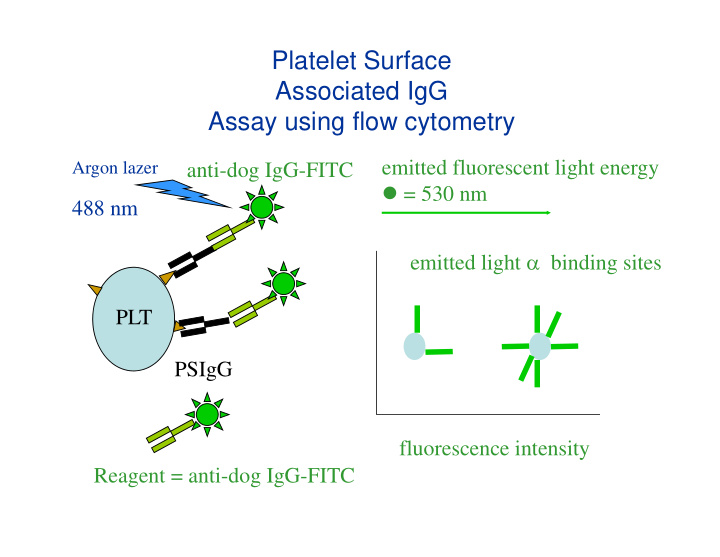



Platelet Surface Associated IgG Assay using flow cytometry emitted fluorescent light energy Argon lazer anti-dog IgG-FITC = 530 nm 488 nm emitted light binding sites PLT PSIgG fluorescence intensity Reagent = anti-dog IgG-FITC
PSAIgG test in healthy dogs Negative control Ab Fluorescence Fluorescence PSAIgG Cut off < 14% for normal dog samples that are 4 hour old < 23% for normal dog samples that are 24 hour old
Case Example of Primary immune-mediated thrombocytopenia (IMT) 11 year old female spayed English Cocker episodic thrombocytopenia responsive to corticosteroid therapy 1,000/ l negative titers to tick borne diseases • RMSF, Lyme’s, Erhlichia normal coagulation profiles Mailed in sample
English Cocker –Primary IMT 39% Positive Size Before treatment 14% Positive Size After 10 days of Prednisone Fluorescence
Case Example of Secondary IMT 6 yr old male Labrador cross Admitted to KSU (In house case) Fever (106 F) Mild anemia (HCT = 30%) 64,000/ l platelets Ataxia Acute titer to RMSF 1:128 Convalescent titer to RMSF 1:2048
Dog with Rocky Mountain Spotted Fever Before treatment 19% positive After 2 days of doxycycline
Dog recovered with treatment Cold IV fluids and doxycycline Responded to treatment by 48 hours
Sensitivity/Specificity of PSAIgG Sensitivity 87.5% (21/24 true positive) • 12.5% (3/24) false negatives – Causes of false negatives » Elution of antibody » Antibody against megakaryocytes or cytokines » Removal of antibody coated cells by the spleen Specificity 100% • 9/9 nonimmune cases – Myelophthisis due to lymphosarcoma – Neoplasia (sequestration or consumption?) Wilkerson, Meinkoth, Harkin, Kocan, et al, 2001;30 Vet. Clin. Path.
Uninfected Control 500 Chronically infected (day -60) Infected Day 0 450 Reinfected Day 0 400 Splenetomized Platelets X 103/ml 350 300 250 Time course 200 150 development 100 of thrombocytopenia 50 0 and PSAIgG 0 5 10 15 20 25 30 35 40 45 50 PSAIgG may be transient in dogs infected 40 with Babesia gibsoni Percent PSAIgG 30 20 10 0 0 5 10 15 20 25 30 35 40 45 50 Days post infection Wilkerson et al, 2001;30 Vet. Clin. Path.
Recommend
More recommend